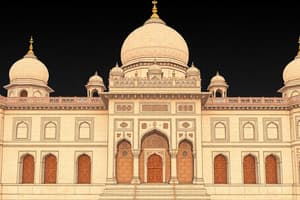Podcast
Questions and Answers
What contributed to the decline of the Mughal Empire?
What contributed to the decline of the Mughal Empire?
- Strengthening central governance under Aurangzeb
- Expansion of the empire beyond the Ganges-Yamuna doab
- Growing resistance from local elites (correct)
- Increasing control over regional powers
Which region was NOT lost to the Maratha confederacy or other Indian kingdoms by the end of the 17th century?
Which region was NOT lost to the Maratha confederacy or other Indian kingdoms by the end of the 17th century?
- Punjab (correct)
- Gujarat
- Malwa
- Bengal
What impact did the rebellion of Raja Prithvi Singh of Bharatpur have on the Mughal Empire?
What impact did the rebellion of Raja Prithvi Singh of Bharatpur have on the Mughal Empire?
- It further weakened imperial power (correct)
- It had no impact on the empire
- It led to increased centralization of power
- It strengthened imperial power
How did decentralization of the Mughal system impact the Rajput kingdoms?
How did decentralization of the Mughal system impact the Rajput kingdoms?
What event marked the beginning of the Mughal Empire's fall around 1750?
What event marked the beginning of the Mughal Empire's fall around 1750?
What was one significant administrative transformation under Aurangzeb in the Mughal Empire?
What was one significant administrative transformation under Aurangzeb in the Mughal Empire?
How did the administrative changes under Aurangzeb affect provincial autonomy?
How did the administrative changes under Aurangzeb affect provincial autonomy?
Which emerging regional power challenged Mughal authority in northern India?
Which emerging regional power challenged Mughal authority in northern India?
What impact did the emergence of regional powers have on the stability of the Mughal Empire?
What impact did the emergence of regional powers have on the stability of the Mughal Empire?
How did the limited land grants under Aurangzeb contribute to local elite resentment?
How did the limited land grants under Aurangzeb contribute to local elite resentment?
Flashcards are hidden until you start studying
Study Notes
The Transformations of the Mughal Dynasty
The Mughal Empire was founded by Babur, who established it in Delhi, India, after defeating Ibrahim Lodi, Sultan of the Kingdom of Delhi. The Mughal Empire went through several transformations over time, particularly during its last phase of existence from the late 17th century to early 18th century. This period saw profound shifts in political structures, military strategies, social practices, economic systems, and cultural traditions within the empire.
Administrative Changes Within the Empire
One significant transformation occurred with regards to administration. Under Aurangzeb, known for his strict enforcement of Islamic law, the central government became more authoritarian, which led to increased administrative control over provinces outside of North India. In addition, land grants were limited and their revenue diverted into state coffers. These actions helped strengthen the financial base of the empire while reducing provincial autonomy, creating a tighter grip on power for the emperor. However, these reforms also caused resentment among local elites, contributing to rebellions against Aurangzeb's rule.
Emerging Regional Powers
During this period, there were also emerging regional powers challenging Mughal authority and control. For example, the Marathas and Jats gained prominence in northern India contesting for territorial supremacy by attacking smaller Mughal garrisons. Furthermore, Raja Prithvi Singh of Bharatpur rebelled from 1722-1727, which weakened imperial power further. Meanwhile, Rajput kingdoms began strengthening themselves militarily and politically due to the decentralization of the Mughal system. The rise of these regional power centers eventually led to major losses of territory throughout much of western India, which reduced the Mughal ruler's ability to assert direct control over vast areas beyond the Ganges-Yamuna doab.
Decline of the Empire
These developments ultimately contributed to the weakening of the Mughal Empire. By the end of the 17th century, important regions like Bengal, Malwa, Gujarat, and Orissa had been lost to the Maratha confederacy or other Indian kingdoms. As regional forces began to take advantage of the fragmented nature of the empire, they disrupted the status quo, leading to a series of conflicts between them that further eroded the empire's strength. The economy suffered greatly under Aurangzeb, and the empire struggled to maintain itself financially. Eventually, the empire fell apart beginning around 1750 when Nadir Shah invaded and sacked Delhi in 1739. Afterward, the Mughal Empire never fully recovered its past glory; many of its former possessions passed into British hands later in the 19th century.
In conclusion, the Mughal dynasty experienced numerous changes in its final years, including tightening central governance under Aurangzeb, growing resistance from local elites, increasing influence from regional powers, and gradual loss of territory. Ultimately, these factors combined to create conditions whereby the once great Mughal Empire declined until it finally ceased to exist as a powerful entity.
Studying That Suits You
Use AI to generate personalized quizzes and flashcards to suit your learning preferences.



